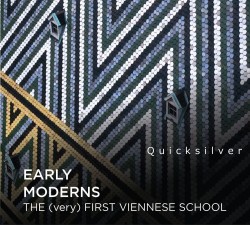 Early Moderns, The (very) First Viennese School
Early Moderns, The (very) First Viennese School
Quicksilver
Independent (gemsny.org/online-store/quicksilver-early-moderns)
Viennese music means Mozart and Haydn. Well, not according to Quicksilver. They have compiled a CD of music from the very familiar venue that is Vienna, but by mainly unfamiliar composers.
Perhaps the strangest factor is Quicksilver’s frequent use of the dulcian, ultimately familiar to Mozart as its descendant the bassoon, here helping to reinforce this school of music’s claims to be recognized in its own right. Dominic Teresi’s vigorous dulcian playing in Giovanni Battista Buonamente’s Sonata prima à 3 is a real highlight.
Throughout the CD, the trombone and dulcian are prominent. This is noteworthy in the Sonata à 3 attributed to Heinrich I. F. von Biber, where Greg Ingles’ dignified trombone-playing proves that Viennese Baroque does not consist exclusively of violin and cello chamber music.
This is not to dismiss the stringed element. Johann Caspar Kerll’s Canzona à 3 in G Minor combines violins and viola da gamba with harpsichord/theorbo continuo. The result is a very lively and highly entertaining composition. One wonders how these pieces came to be so neglected.
And yet, there is still room for solo compositions for more established instruments. Avi Stein’s harpsichord skills are tested more and more intensively as Kerll’s Passacaglia variata unfolds, making demands worthy of Bach or Couperin on the player. Kerll is perhaps the most overlooked composer on a CD of a certainly overlooked school of music.



